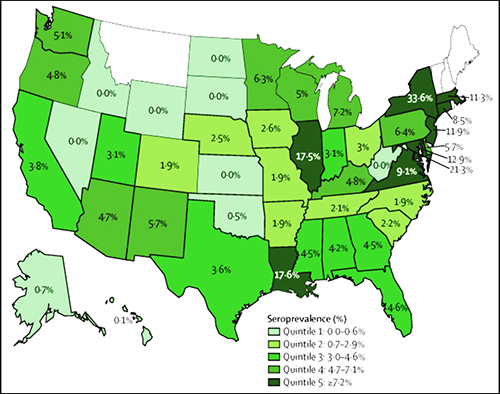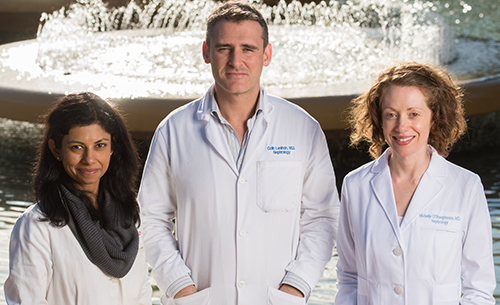Researchers conducted antibody testing on ‘remainder plasma,’ which could inform strategies for ongoing SARS-CoV-2 clinical laboratory surveillance testing
In a clever use of stored clinical laboratory specimens, researchers in California conducted a nationwide seroprevalence survey—serology testing to determine the number of people in a population that carry a specific disease—that used “remainder plasma” from dialysis patients to look for antibodies to the COVID-19 infection. They found that—as of July—fewer than one in 10 adults tested had acquired antibodies to the SARS-CoV-2 coronavirus.
According to Julie Parsonnet, MD, Stanford Professor of Medicine and of Epidemiology and Population Health, and a study author, this indicates that the US population is a long way from herd immunity to COVID-19. “This is the largest study to date to confirm that we are nowhere near herd immunity,” she said in a Stanford Medicine press release.
Herd immunity is the point at which a large part of the population becomes immune to a specific disease. Scientists, according to the Stanford press release, estimate that 60%-70% of the population must have antibodies to the coronavirus before COVID-19 fades.
The study published in The Lancet, titled, “Prevalence of SARS-CoV-2 Antibodies in a Large Nationwide Sample of Patients on Dialysis in the USA: A Cross-Sectional Study,” was a collaboration between California’s Ascend Clinical Laboratories and Stanford University School of Medicine.

Dense Urban Populations at Greater Risk for COVID-19
The Stanford researchers analyzed samples of remainder plasma from 28,503 randomly selected patients receiving dialysis in July at more than 1,300 dialysis facilities in 46 states. They found that 8% of people were positive for COVID-19 antibodies, which when standardized to the US adult population, equals 9.3% nationwide, the study notes.
However, they also found that people living in densely populated areas were 10 times more likely to show evidence of past COVID-19 infection, and that people living in predominantly black and Hispanic neighborhoods were two to three times more likely to be seropositive than those in white neighborhoods, the researchers wrote.
Of the use of remainder plasma for their study, the researchers wrote, “Testing remainder plasma from monthly samples obtained for routine care of patients on dialysis for SARS-CoV-2 antibodies therefore represents a practical approach to a population-representative surveillance strategy, informing risks faced by a susceptible population while ensuring representation from racial and ethnic minorities.
“In addition, seroprevalence surveys in patients receiving dialysis can be linked to patient-level and community-level data to enable evaluation and quantification of differences in SARS-CoV-2 prevalence by demographic and neighborhood strata, and thus facilitate effective mitigation strategies targeting the highest-risk individuals and communities,” added the researchers.
As reported in Physician’s Weekly, the study also found:
- When standardized to the US dialysis population, seroprevalence ranged from 3.5% (95% CI, 3.1-3.9) in the West to 27.2% (95% CI, 25.9-28.5) in the Northeast.
- Large variations in seroprevalence by state were seen, with early COVID-19 hot spots such as New York (33.6%), Louisiana (17.6%), and Illinois (17.5%) having higher rates than neighboring states—Pennsylvania (6.4%), Arkansas (1.9%), and Missouri (1.9%).
- When compared with other measures of SARS-CoV-2 spread, seroprevalence correlated best with deaths per 100,000 population.

Nearly 10% of COVID-Positives Are Undiagnosed
In another important finding that compared seroprevalence and case counts per 100,000 population as of June 15, the study reports that only 9.2% of the COVID-19 seropositives had been diagnosed with the disease.
Because dialysis patients get monthly laboratory blood tests that generate leftover blood plasma samples, researchers believe this remainder plasma can serve an important role in tracking COVID-19’s prevalence in the general population.
“Not only is this patient population representative of the US population, but they are one of the few groups of people who can be repeatedly tested,” said Anand in the Stanford press release. “This is a potential strategy for ongoing SARS-CoV-2 antibody testing and surveillance.”
In an accompanying editorial in The Lancet, titled, “SARS-CoV-2 Antibody Seroprevalence in Patients Receiving Dialysis in the USA,” UK researchers Barnaby Flower, PhD, Department of Infectious Disease, Faculty of Medicine, Imperial College London, and Christina Atchison, PhD, Faculty of Medicine, School of Public Health, Imperial College London, praised the Stanford research.
“Questions remain around the longevity of the immune response and correlates of protection, but high-quality longitudinal serosurveillance with accompanying clinical data can help to provide the answers,” they wrote. “Anand and colleagues deserve credit for pioneering a scalable sampling strategy that offers a blueprint for standardized national serosurveillance in the USA and other countries with a large haemodialysing population.”
Pandemic Fatigue and the Vaccine
While the promised vaccine provides hope for an end to the pandemic, experts say the battle is far from won.
“We are still in the middle of the fight,” epidemiologist Eli Rosenberg, PhD, Associate Professor at the University at Albany in New York, who was not part of the Stanford study, told the Washington Post, “We’re all tired, and we’re all hoping for a vaccine. This shows us how it’s not over here, not even by a long shot.”
What is obvious is that clinical laboratories will continue to play a vital role in response to the COVID-19 pandemic. In fact, just as the management and scientific team at Ascend Clinical Laboratories recognized that remainder plasma from testing dialysis patients could be the foundation of a national seroprevalence survey for COVID-19, other clinical laboratories in different regions of the United States may have similar resources that can be adapted as tools to study and understand the SARS-CoV-2 pandemic.
—Andrea Downing Peck
Related Information:
Fewer than 1 in 10 Americans Show Signs of Past Coronavirus Infection, Large National Study Shows
Fewer than 1 in 10 Americans Have Antibodies to Coronavirus, Study Finds
SARS-CoV-2 Antibody Seroprevalence in Patients Receiving Dialysis in the USA




